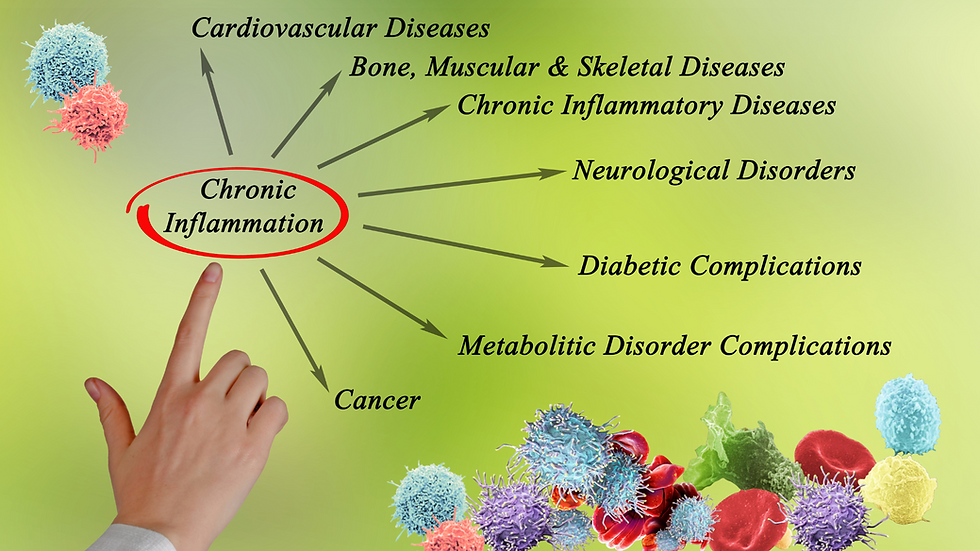What Is Inflammation? The Good, the Bad, and the Chronic
- Dr. Nazanin Safaei, ND, MS

- Jul 9
- 3 min read
Updated: Jul 10

Inflammation is a critical function of the immune system, designed to protect the body from harm. Imagine your body’s defense system as a vigilant guardian, always ready to spring into action at the first sign of trouble; this is inflammation at work. But when inflammation becomes chronic or unregulated, it can be a hidden driver of disease. In this article, we’ll explore the difference between healthy and unhealthy inflammation, what causes inflammation to go awry, and signs and symptoms caused by inflammation.
What Is Inflammation?
Inflammation is the body’s natural response to injury, infection, or harmful stimuli. It’s the immune system’s way of initiating healing. These responses are triggered by immune cells releasing inflammatory mediators like cytokines and prostaglandins to fight off invaders and repair tissue.
There are two main types of inflammation:
Acute inflammation: A short-term, protective response that helps the body heal. Examples include a sore throat from a cold or swelling from a cut.
Chronic inflammation: A long-term, persistent inflammatory response that can be damaging. It often occurs silently or manifests as subtle signs, and is associated with many chronic diseases.
Some of the classic signs and symptoms of inflammation are listed in the picture below. In the presence of inflammation you may experience one or more of these symptoms.

Healthy vs. Unhealthy Inflammation
Healthy Inflammation
Acute inflammation is beneficial and necessary. It:
Defends against infections
Initiates tissue repair
Alerts the immune system to injury
Once healing is complete, anti-inflammatory signals turn off the immune response, returning the body to balance.
Unhealthy (Chronic) Inflammation
Chronic inflammation occurs when the immune system remains activated even without an immediate threat. This may result from:
Persistent infections
Autoimmune disorders
Exposure to environmental toxins
Chronic stress
Poor diet (e.g., high in sugar, processed foods, or trans fats)
Obesity and metabolic dysfunction
Over time, this can lead to tissue damage, scarring, and loss of function in affected organs. For more information about consequences of chronic inflammation visit my blog post: "The Silent Fire Within: How Chronic Inflammation Fuels Today’s Top Diseases".
Final Thoughts
Inflammation isn’t inherently bad—it’s a vital defense mechanism. But when it becomes chronic and uncontrolled, it can be a silent contributor to many serious health conditions. Identifying and addressing the root causes of chronic inflammation through diet, lifestyle, and functional medicine can help restore balance and support long-term wellness. In the next post, "Why You’re Inflamed: Common Causes of Chronic Inflammation You Might Be Missing", we'll explore the underlying causes of chronic inflammation and consequences of untreated chronic inflammation.
Disclaimer: The information provided in this article is for informational and educational purposes only and is not intended as medical advice, diagnosis, or treatment. Always consult with a qualified healthcare provider before making changes to your diet, lifestyle, or health care regimen.
References
Medzhitov R. Origin and physiological roles of inflammation. Nature. 2008;454(7203):428-435. doi:10.1038/nature07201
Furman D, Campisi J, Verdin E, et al. Chronic inflammation in the etiology of disease across the life span. Nat Med. 2019;25(12):1822–1832. doi:10.1038/s41591-019-0675-0
Hotamisligil GS. Inflammation and metabolic disorders. Nature. 2006;444(7121):860–867. doi:10.1038/nature05485
Tilg H, Moschen AR. Food, immunity, and the microbiome. Gastroenterology. 2015;148(6):1107-1119. doi:10.1053/j.gastro.2014.12.036
Slavich GM, Irwin MR. From stress to inflammation and major depressive disorder: a social signal transduction theory of depression. Psychol Bull. 2014;140(3):774–815. doi:10.1037/a0035302
Chen L, Deng H, Cui H, et al. Inflammatory responses and inflammation-associated diseases in organs. Oncotarget. 2018;9(6):7204–7218. doi:10.18632/oncotarget.23208
Nathan C, Ding A. Nonresolving inflammation. Cell. 2010;140(6):871–882. doi:10.1016/j.cell.2010.02.029
Dantzer R, O’Connor JC, Freund GG, Johnson RW, Kelley KW. From inflammation to sickness and depression: when the immune system subjugates the brain. Nat Rev Neurosci. 2008;9(1):46–56. doi:10.1038/nrn2297
©2025 by Nazanin Safaei, ND, MS


